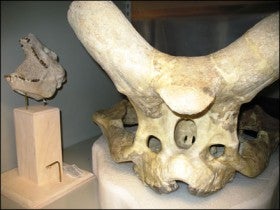Hidden Gems: Imaginations run wild in Museum of Natural History – and its lesser-known Museum Collections
The top part of the skull of a brontothere, a 9-foot tall creature, lurks inside a cabinet of the vertebrate paleontology collection.
Parts of it are a vampire's walk-in closet, drawers lined with bats and bugs. Elsewhere, it's Mother Nature's library, shelves of oversized books stuffed with aromatic samples of pine needles and native grasses. A spare parts shop for dinosaurs has its footprint in a basement.
Naturally, the imagination runs wild at the Museum Collections at the University of Colorado at Boulder, the places where natural and historical objects are cataloged exhaustively for research. Many of the items move in and out of displays at the University of Colorado Museum of Natural History, which is reopening this weekend after months of renovation and repair. But many stay in their steel condos, painstakingly organized in drawers, cabinets and shelves to provide resources for scientific exploration.
In the collection of vertebrate paleontology, you won't find any giant dinosaurs – those go to the Denver Museum of Nature and Science. But there are 8,000 specimens of history's creatures, including some fish that are 500 million years old. Collection Manager Toni Culver keeps an eye on them all. Nearby, Talia Karim, her counterpart for invertebrate paleontology, keeps rare samples of amber under lock and key, and checks on yard-long squids that swam in the shallow oceans of Colorado and Kansas when dinosaurs roamed here.
Elsewhere in the Museum Collections building, Virginia Scott, collection manager for entomology, calls herself a bee person. She's in the right place, with 100,000 examples to keep her company. She figures she can find a few to provide to an upcoming exhibit on bees and grasshoppers at the museum. Some of the collection's 600,000 insects date back to 1877.
Collection Manager Talia Karim with a drawer of amber fossils in the invertebrate paleontology collection.
The invertebrate zoology collection managed by Gene Hall boasts nearly 1 million specimens – corals, sponges and one of the top university-housed collections of mollusks. Mariko Kageyama, collection manager of vertebrate zoology, gets to be friends with bats and snakes – perfectly captivating for children's workshops.
Objects in one of the collections are so small, they can only be seen with a microscope. Josh Stepanek, a graduate research assistant, shows visitors slides of diatoms, living algae that provide insight into water quality studies. Patrick Kociolek, director of the Museum of Natural History, is an internationally known expert on diatoms.
Not all the collections are housed in the Museum Collections building. Nan Lederer, a collection manager at the herbarium in the Clare Small Building, tends to a half-million plant specimens which, once dried and pressed, can remain preserved for centuries. Some grasses here were collected before AD 700. Spearmint samples still give off a sweet smell.
"You never know what someone might want to do with it, but it's here if they need it," Lederer said.
In the Henderson Building where the museum is based, Christie Cain, anthropology collection manager, keeps tabs on 1.5 million objects, ranging from the sublime (a 1,000-year-old flicker feather headdress with ermine trim) to the ridiculous (a "mermaid" skeleton, the type commissioned by P.T. Barnum, that's likely built of parts of a monkey and a fish). Only a very small percentage of the collection is ever on display in the museum.
This flicker feather headdress is among the highlights in the anthropology collection.
UCM06178 University of Colorado Museum of Natural HistoryThis flicker feather headdress is among the highlights in the anthropology collection.
As for the museum, admission is free seven days a week. Students love the Bio Lounge, a study area that includes rotating museum displays. Coffee and tea are free during the day, too. A permanent anthropology hall sits on the other side of the basement.
Upstairs, the paleontology hall shows off dinosaurs and other fossils; another gallery will house a variety of displays: those aforementioned bees and grasshoppers, plus snakes and exhibits on nature-based poetry and biomimicry (design that's based on nature).
"We're trying to overcome our anonymity on campus," said Kory T. Katsimpalis, who handles visitor services and coordinates the museum's blog. For details on the museum's reopening and other events, click here.




